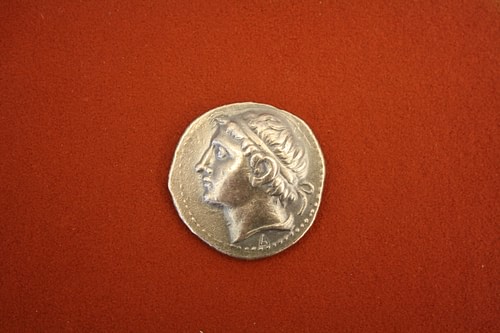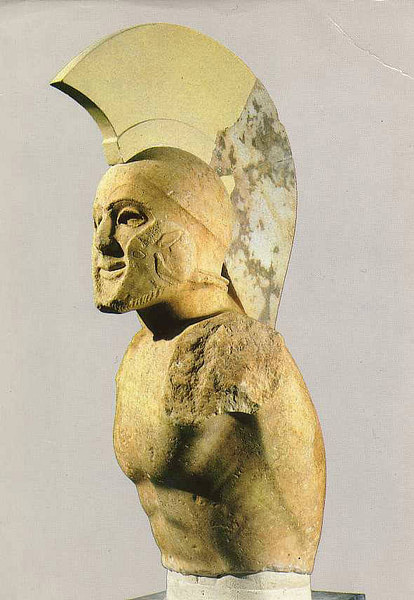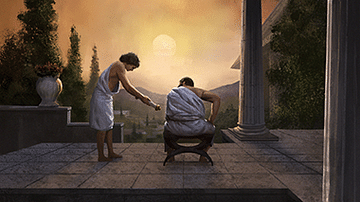
Sparta was one of the most important city-states in ancient Greece and was famous for its military prowess. The professional and well-trained Spartan hoplites with their distinctive red cloaks and long hair were probably the best and most feared fighters in Greece, fighting with distinction at key battles against the Persian army at Thermopylae and Plataea in the 5th century BCE.
The city of Sparta was also in constant rivalry with the other major Greek cities of Athens and Corinth and became involved in two protracted and hugely damaging conflicts, the Peloponnesian Wars of the mid- to late-5th century BCE and the Corinthian Wars of in the early 4th century BCE.
Sparta in Mythology
In Greek mythology the founder of the ancient city was Lacedaemon, a son of Zeus, who gave his name to the region and his wife's name to the city. Sparta was also an important member of the Greek force which participated in the Trojan War. Indeed, the Spartan king Menelaus instigated the war after the Trojan prince Paris abducted his wife Helen, offered to Paris by the goddess Aphrodite as a prize for choosing her in a beauty contest with fellow goddesses Athena and Hera. Helen was said to have been the most beautiful woman in Greece and Spartan women in general enjoyed a reputation not only for good looks but also spirited independence.
Establishing Regional Dominance
Sparta was located in the fertile Eurotas valley of Laconia in the southeast Peloponnese. The area was first settled in the Neolithic period and an important settlement developed in the Bronze Age. Archaeological evidence, however, suggests that Sparta itself was a new settlement created from the 10th century BCE.
In the late 8th century BCE, Sparta subjugated most of neighbouring Messenia and its population was made to serve Spartan interests. Sparta thus came to control some 8,500 km² of territory making the polis or city-state the largest in Greece and a major player in Greek politics. The conquered peoples of Messenia and Laconia, known as perioikoi, had no political rights in Sparta and were often made to serve with the Spartan army. A second and lower social group was the helots, semi-enslaved agricultural labourers who lived on Spartan-owned estates. Intermediary between the helots and the perioikoi were the liberated helots or neodamōdeis. Spartan citizens did not indulge in farming activities themselves but devoted their time to military training, hunting, war, and politics. The helots could keep a percentage of the produce they cultivated, but they were also regularly purged to keep them firmly in their social place and they could also be conscripted into military duties in times of war.
The relationship between citizens and helots was an uneasy one and there were sometimes uprisings, notably in the 7th century BCE which contributed to Sparta's defeat to Argos at Hysiae in 669 BCE. Sparta gained revenge on Argos in c. 545 BCE but then lost a battle with Tegea shortly after. This regional instability brought about the Peloponnesian League (c. 505 to 365 BCE) which was a grouping of Corinth, Elis, Tegea, and other states (but never Argos), where each member swore to have the same enemies and allies as Sparta. Membership of the League did not necessitate the paying of tribute to Sparta but rather the provision of troops. The League would allow Sparta to establish hegemony over and dominate the Peloponnese until the 4th century BCE. In addition to local politics, from the 6th century BCE Sparta began to broaden her horizons by, for example, creating an alliance with Croesus of Lydia and sending an expedition against Polycrates of Samos in c. 525 BCE.
Rivalry with Athens, Thebes & Corinth
Sparta, under Cleomenes (c. 520-490 BCE), overthrew the tyrants of Athens but the resulting democracy put a stop to any Spartan ambitions in the city. Sparta was, however, an ally with Athens in the defence of Greece against the invasion of Persian king Xerxes, and fought with distinction at Thermopylae in 480 BCE and at Plataea one year later. From 480 to 460 BCE regional rivalries and revolts by the helots damaged Sparta and worse were to follow when rivalry with Athens developed into the Peloponnesian Wars from c. 460 to 446 BCE and again from 431 to 404 BCE. The long wars were damaging to both sides but Sparta, with some Persian help, finally won the conflict when Lysander destroyed the Athenian fleet at Aegospotami in 405 BCE. Sparta's position as the number one city-state in Greece, though, was to be short-lived.
Continued Spartan ambitions in central and northern Greece, Asia Minor, and Sicily once again dragged the city into another protracted conflict, the Corinthian Wars with Athens, Thebes, Corinth, and Persia from 396 to 387 BCE. The result of the conflict was the 'King's Peace' where Sparta ceded her empire (for which she in any case lacked the necessary bureaucratic apparatus to manage properly) to Persian control but Sparta was left to dominate Greece. However, trying to crush Thebes, Sparta lost the crucial battle of Leuctra in 371 BCE against the brilliant Theban general Epaminondas. Thebes then annexed parts of Messenia and Sparta became thereafter only a second-rate power.
After briefly challenging Macedonian control in the 3rd century BCE and being besieged by Pyrrhus in 272 BCE, Sparta never regained her former glory and she was compelled to join the Achaean Confederacy in 195 BCE. Under Roman control Sparta was permitted to leave the confederacy in 147 BCE which prompted the Achaean War. However, as a free city in the Roman world things did improve for Sparta, and the city enjoyed good relations with her conquerors but the end finally came for Sparta in 396 CE when the Visigoth king Alaric sacked the city.
Government
The Spartan political system was unusual in that it had two hereditary kings from two separate families. These monarchs were particularly powerful when one of them led the army on campaign. The kings were also priests of Zeus and they sat on the council of elders known as the gerousia. This body consisted of 28 over-60 years of age males who held the position for life. The gerousia led the citizen assembly, probably proposing issues on which to vote and it was also the highest court in Sparta. The assembly (Ekklēsia) met once a month and was open to all citizens who voted by the simple method of shouting. There was also an executive committee of five ephors (ephoroi) chosen by lot from the citizen body, able only to serve for a maximum of one year and who were ineligible for future office. Two of the ephors also accompanied one of the kings when on campaign. Just how these different political elements interacted is not known for certain but clearly a degree of consensus was necessary for the state apparatus to function. It may also explain Sparta's reputation as being a conservative state slow to make decisions in foreign policy.
Society
Like all Greek societies Sparta was dominated by male citizens and the most powerful of those came from a select group of families. These were the landed aristocracy, and following reforms credited to Lycurgus in the 6th century BCE (or even earlier), citizens could not indulge in agricultural activities - this was the lot of the helots - but they had to devote themselves to athletic and military training and politics. Helots could not own property and so could not rise to become full-citizens, and this lack of social mobility would come back to haunt Sparta in later centuries. Reduced by constant wars in the 5th and 4th centuries BCE, the Spartan hoplites (homoioi) became dangerously small in number (8,000 in 490 BCE to 700 in 371 BCE), so much so, that non-Spartiate soldiers had to be enlisted and their loyalty and interest in Sparta's ambitions was questionable.
Women in the Sparta city-state had a better lot than in other Greek cities. Spartan women could own property which they often gained through dowries and inheritances. In fact, Spartan women became amongst the richest members of society, as their men were killed in the many wars, and eventually controlled 2/5th of Spartan land. In addition, Spartan women could also move around with reasonable freedom, they could enjoy athletics (done in the nude like men), and even drink wine. All of these freedoms would have been unacceptable in other Greek poleis.
There were foreigners (xenoi) in Spartan society but these were not as welcome as in other city-states, and those that did live in Sparta were sometimes forcibly expelled by their overly suspicious and at times positively paranoid hosts.
Spartan Army
For all Spartan citizens there was a strong emphasis on military training and frugal living in communal mess halls where simple food such as barley meal, cheese, figs and wine were the norm. From the age of seven, males had a militaristic upbringing known as the agōgē where they were separated into age groups and lived in barracks. These youths pursued rigorous athletic and military training which became even more demanding from the age of 20, when they joined common mess halls (syssition) where they often formed homoerotic relations with older, more experienced citizens. This tough training resulted in a professional hoplite army capable of relatively sophisticated battle manoeuvres and made them feared throughout Greece, a fact perhaps evidenced by Sparta's notable lack of fortifications for most of its history.
A peculiar feature of the Spartans and their military was the great importance given to matters of religion. As Herodotus put it, they 'considered the things of the gods more weighty than the things of men'. Pre- and post-battle sacrifices were a common feature of Greek warfare in general but the Spartan army took things one step further and sacrificed before crossing rivers, for example, and even withheld from mobilising the army if an important religious festival was ongoing. Famous episodes where the Spartans put religion above warfare and even national crisis were at Marathon and Thermopylae during the Greco-Persian Wars. In the former battle, the Spartan soldiers arrived too late to assist the other Greek cities and in the latter mobilised only a token force as they felt compelled to first celebrate the Karneia festival in honour of Apollo.
The Spartan hoplite army, however, showed the rest of Greece the way forward towards a greater military professionalism and considering the iconic image of fearless and disciplined hoplites with red cloaks and lambda-emblazoned shields, for the Greeks, admiring Romans and even 21st century film-goers, this is Sparta.








